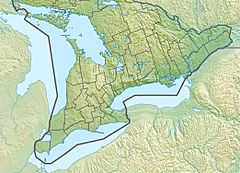Bear Brook (Ontario) facts for kids
Quick facts for kids Bear Brook |
|
|---|---|
|
Location of the mouth of Bear Brook in Southern Ontario
|
|
| Other name(s) | ruisseau Bear |
| Country | Canada |
| Province | Ontario |
| County | Prescott and Russell |
| Municipalities |
|
| Physical characteristics | |
| Main source | Confluence of two unnamed streams Edwards 70 m (230 ft) 45°20′54″N 75°27′49″W / 45.34833°N 75.46361°W |
| River mouth | South Nation River The Nation 48 m (157 ft) 45°25′11″N 75°04′13″W / 45.41972°N 75.07028°W |
| Basin features | |
| Progression | South Nation River→ Ottawa River→ Saint Lawrence River→ Gulf of Saint Lawrence |
| River system | Ottawa River drainage basin |
Bear Brook (also known as French: ruisseau Bear in French) is a small stream in eastern Ontario, Canada. It flows through parts of Clarence-Rockland, The Nation, and the city of Ottawa.
This brook starts in the fields and forests north of Edwards. It then flows mostly towards the east. Bear Brook eventually joins the South Nation River as one of its left-side branches.
Contents
Communities Along Bear Brook
Several communities are located along Bear Brook. These towns and villages have grown up near the stream over time.
- Edwards
- Carlsbad Springs
- Bearbrook
- Cheney
- Bourget
History of Bear Brook's Use
In the mid-1800s, Bear Brook was an important waterway. People used it for different purposes.
Floating Timber to Sawmills
Loggers used Bear Brook to move cut trees. This process is called log driving. They would float large pieces of timber down the brook. The timber was taken to sawmills in places like Carlsbad Springs. These sawmills operated from 1854 to 1905.
Transportation for Settlers
Early settlers also used the brook for travel. It helped them reach their homesteads. A homestead was a piece of land where a family built their home.
Changes in Use
However, Bear Brook was often too small. It would dry up a lot in the summer. Because of this, people stopped using it for transportation quite quickly. This happened especially after Russell Road was built. The forests around the brook were also cut down. This means the brook now drains water faster than it used to.


